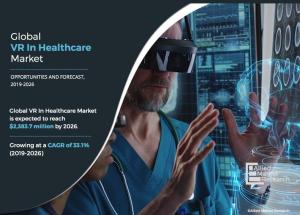CAGR of 33.18% VR in Healthcare Market to 2026
PORTLAND, OREGON, UNITED STATES, June 14, 2024 /EINPresswire.com/ -- Virtual reality (VR) is poised to revolutionize the healthcare industry, with the global market size valued at $240.91 million in 2018 and projected to soar to $2,383.68 million by 2026. This remarkable growth, registering a compound annual growth rate (CAGR) of 33.18% from 2019 to 2026, is driven by several key factors.
𝐆𝐞𝐭 𝐚 𝐒𝐚𝐦𝐩𝐥𝐞 𝐂𝐨𝐩𝐲 𝐨𝐟 𝐭𝐡𝐢𝐬 𝐑𝐞𝐩𝐨𝐫𝐭: https://www.alliedmarketresearch.com/request-sample/A06193
Driving Forces Behind VR in Healthcare
1. Rising Neurological Disorders: There is an increasing incidence of neurological disorders, necessitating innovative diagnostic and treatment methods. VR's immersive capabilities provide significant advancements in this area, offering new ways to understand and treat these conditions.
2. Innovative Diagnostic Techniques: VR is becoming an essential tool in diagnostics, complementing traditional methods like MRI and CT scans. Its ability to create 3D visualizations aids in better diagnosis and treatment planning.
3. Increased Awareness and Technological Advancements: The growing awareness of VR's benefits in healthcare, coupled with advancements in technology such as improved computers, mobile applications, and internet connectivity, is further propelling market growth.
Despite these drivers, the market faces challenges such as high treatment costs, data privacy concerns, and limited accessibility in developing regions. However, the expanding use of VR in advanced dental procedures and cancer therapies presents lucrative opportunities for future growth.
Applications of VR in Healthcare
VR is transforming the healthcare landscape by integrating IT solutions across various medical fields. Here are some of its key applications:
• Medical Training: VR provides immersive training environments for medical professionals, enhancing their skills without the risks associated with real-life practice.
• Surgical Assistance: Surgeons can use VR for preoperative planning and intraoperative guidance, improving precision and outcomes.
• Patient Treatment: VR helps treat conditions like anxiety, phobias, and pain through cognitive distraction and immersive therapy techniques.
• Disease Awareness and Medical Marketing: VR creates engaging and informative experiences for patient education and marketing purposes.
Market Segmentation
1. By Product: The market is segmented into VR semiconductor components, devices, sensors, and others. VR sensors dominated in 2018, mainly due to their critical role in movement and gesture tracking during surgeries.
2. By Technology: Technologies include head-mounted displays, gesture-tracking devices, and projector & display walls. Projector & display walls are expected to see significant growth, offering convenience and the ability to involve multiple users in
𝐄𝐧𝐪𝐮𝐢𝐫𝐞 𝐁𝐞𝐟𝐨𝐫𝐞 𝐁𝐮𝐲𝐢𝐧𝐠: https://www.alliedmarketresearch.com/purchase-enquiry/A06193
David Correa
Allied Market Research
+1 800-792-5285
email us here
Visit us on social media:
Facebook
Twitter
Legal Disclaimer:
EIN Presswire provides this news content "as is" without warranty of any kind. We do not accept any responsibility or liability for the accuracy, content, images, videos, licenses, completeness, legality, or reliability of the information contained in this article. If you have any complaints or copyright issues related to this article, kindly contact the author above.

